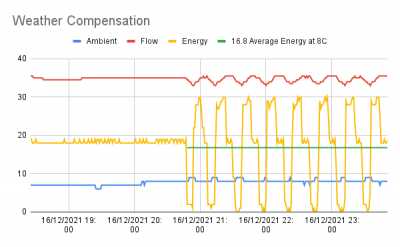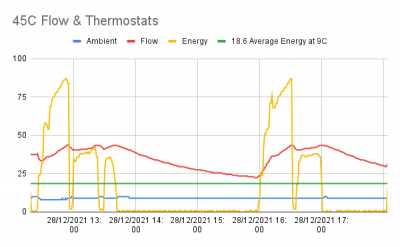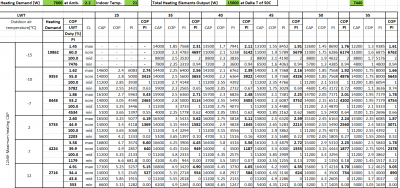ASHP Cycling On/Off - Is it an issue?
Hi @hydros
I'm not an expert on balancing, but you could try the following.
Open up all the radiator valves fully, noting how many turns to fully open from their present setting, so that you can always go back to the start position.
Allow the room temperatures to stabilise and then measure the temperature in the centre of each room.
Gradually close the lockshield valve in the warmest room, a quarter turn at a time, until the desired temperature is achieved.
Continue the above going down the order from warmest room to coolest room.
Recheck the temperature of each room and make adjustments as necessary, until all rooms are at the desired temperature.
Obviously for bedrooms use the TRV's to set a lower desired temperature.
Here are a few thoughts and pictures about cycling. I can only speak about my situation and ASHP (Mitsubishi) but it may help the wider debate. I've been looking through my data logs and this is what happens at around 8C outside temperature. As the temperature rises, the ASHP can't modulate down enough to keep to the weather compensation flow setting so turns on and off
The cycling is about 3 times per hour. The green line is the average energy consumed during the cycling. It's worth pointing out that a steady 20 on the energy scale is 1.2kW so consumption is quite low here. That's to heat the whole house to 20-21C.
This is what happens at about the same outside temperature when using a constant flow rate of about 44C and using the room thermostats. The cycling is controlled largely by the thermostats.
The cycling has reduced but is it using less energy? I'll post the full results of the experiment in a couple of days when I have more cold weather data. It's hard to tell from snapshots like this but it's looking like the weather compensation method uses significantly less energy per day at all temperatures sampled.
I've put my numbers in to your modelling sheet. Not entirely sure I understand what is that's going on, but if I'm reading it correctly I think it says that at 7C outside, I don't have enough output capacity within my radiators to run at a LWT below 35C. FYI - I have an 11kw Daikin system, so slightly smaller than yours but I can't find the details online to be able to update the performance figures.
Not sure it makes much difference but the total emitter output at deltaT50C is 21500w, another thing incorrect on the original installers heat loss report.
Hi @hydros
The reason that I suggested that you look at the modelling tool, was so that you could see the effect on efficiency of changes to insulation levels and heat emitter output.
If you cannot find appropriate Daikin data to repopulate the spreadsheet, you could try using the data for a similar sized Ecodan.
Obviously, by increasing the heat energy output capacity of your heat emitters, your system could operate at lower water flow temperatures, but a similar effect can by achieved by reducing heat demand with improved insulation. Both methods will reduce energy consumption and improve efficiency.
Thanks Derek
Ive used your numbers, I don’t think they are far off my pump, the Daikin is smaller but isn’t quite as efficient, so close enough for a mess about.
I have now completely disabled the thermostat in my system by changing the settings and the heat pump is operating even better. If you recall, my remote thermostat appeared to be suffering interference so I moved it next to the receiver, well it’s still be switching off/on occasionally. With the thermostat completely removed the system is working way better but it’s cold now so you’d expect cycling to reduce anyway, it’ll be interesting to see how it performs when we get a few warmer days.
The feedback from this forum has been so valuable in helping me get to this point. I’ll let it run a little longer before sharing the feedback with my installer.
Posted by: @hydrosThanks Derek
Ive used your numbers, I don’t think they are far off my pump, the Daikin is smaller but isn’t quite as efficient, so close enough for a mess about.
I have now completely disabled the thermostat in my system by changing the settings and the heat pump is operating even better. If you recall, my remote thermostat appeared to be suffering interference so I moved it next to the receiver, well it’s still be switching off/on occasionally. With the thermostat completely removed the system is working way better but it’s cold now so you’d expect cycling to reduce anyway, it’ll be interesting to see how it performs when we get a few warmer days.
The feedback from this forum has been so valuable in helping me get to this point. I’ll let it run a little longer before sharing the feedback with my installer.
Thanks Hydros,
It is in fact a sorry state when the customers are having to educate the installers.
@derek-m, you are so right. I'm getting more and more disillusioned with each passing comment at how many incompetent and/or lazy installers there are out there, which isn't doing the UK any favours on its path to net zero.
Get a copy of The Ultimate Guide to Heat Pumps
Subscribe and follow our YouTube channel!
the industry is set up as the boiler industry to exploit U.K. consumers
Installers are poorly supported which is why this London based heating engineer won’t be touching an ASHP any time soon
Professional installer
-
Weather compensation- why you should use it
18 hours ago
-
Rodents! A word of warning for heat pump owners
21 hours ago
-
Where has Watson gone?
22 hours ago
-
First time wall mounting an ASHP
2 months ago
-
How can I programme a setback for my Samsung Gen6 8kW heat pump?
2 months ago
- 26 Forums
- 2,396 Topics
- 54.3 K Posts
- 335 Online
- 6,077 Members
Join Us!
Worth Watching
Latest Posts
-
RE: Radiator sizing sanity check
@jamespa Luckily I have the whole process documented...
By Papahuhu , 8 minutes ago
-
RE: Recommended home battery inverters + regulatory matters - help requested
@batpred, @transparent thanks Since the i...
By JamesPa , 31 minutes ago
-
RE: Advice for a novice on Mitsubishi Ecodan 6kW
I hadn't spotted that there were two pumps in the UFH (...
By JamesPa , 2 hours ago
-
RE: Setback savings - fact or fiction?
Never assume it makes an ass of u and me! You need the...
By JamesPa , 2 hours ago
-
RE: New Mitsubishi Ecodan 11.2kW installation - L9 errors and maybe more
Before I answer your specific questions just one more t...
By JamesPa , 2 hours ago
-
RE: Help me keep the faith with my air source heat pump installation
@agentgeorge Fortunately the one thing that you *won't*...
By dr_dongle , 2 hours ago
-
RE: ASHP Energy Consumption: Aira 12kW heat pump
@chandykris Thank you for your detailed response.It is ...
By Wally , 3 hours ago
-
RE: Electricity price predictions
Great point, one of the key ones in my chat with Octopu...
By Batpred , 13 hours ago
-
RE: Running from backup generaor in powercut?
Definitely and professionals sometimes miss it. I had...
By Batpred , 13 hours ago
-

RE: New Fogstar 15.5kWh upright solution
Let me point out that there are many Chinese suppliers ...
By Transparent , 17 hours ago
-

RE: Weather compensation- why you should use it
@majordennisbloodnok — The Two Ronnies Mastermind sketc...
By cathodeRay , 18 hours ago
-
Just realised that this image of the cylinder cupboard ...
By Sheriff Fatman , 21 hours ago
-

RE: Rodents! A word of warning for heat pump owners
Two thoughts: 1: Let's ask @david-s if Primary Pro in...
By Transparent , 21 hours ago
-
RE: Solis S6-EH1P8K-L-PLUS – Why I Chose It and What I’ve Learned So Far
In the diagram below, I describe my understanding of th...
By Batpred , 22 hours ago
-
I need to have a look out for it. I know IBM feeds some...
By Batpred , 22 hours ago
-
-
RE: Daikin Atherma ASHP Cycling 6 Times an Hour?
Thanks for your reply. Yes that's a good idea to try a...
By John Marshall , 1 day ago
-

RE: Hot water heating in parallel with space heating
An external heat exchanger would need a pump which woul...
By bontwoody , 1 day ago
-
RE: Gen 6 Samsung ASHP losing 20C of DHW in 60 min directly after generation
@ecobaker Thanks for this. I've had it in both slots. ...
By andbeck , 2 days ago
-

RE: Air source heat pump circuit not operational
Welcome to the forums. If the thermostat shows it’s c...
By Mars , 2 days ago









